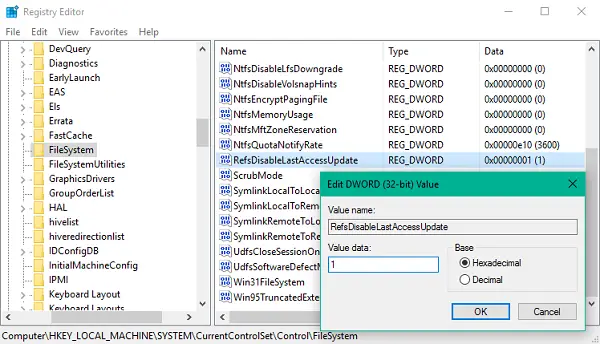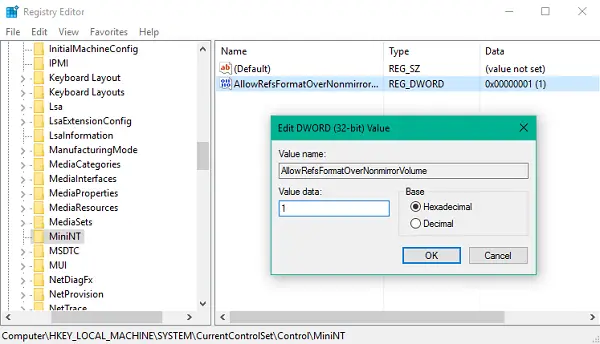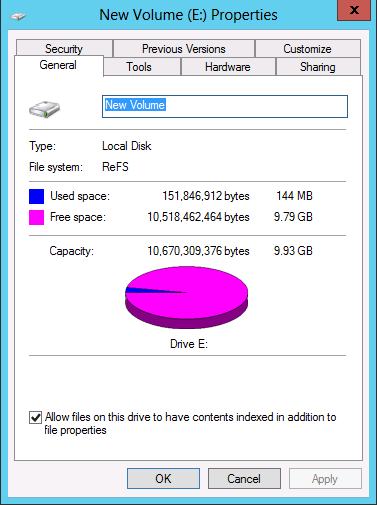How to disable or enable ReFS or Resilient File System
Since the time NTFS was devised and formulated in the Windows Bone, information storage requirements have drastically changed. There was a dire need for a next-generation file system which could work well and take intendance of the issues which were present in NTFS. That's when Microsoft called the shots and developed ReFS (Resilient File Organisation) dorsum in 2022 – and was introduced in Windows 8.i and Windows Server 2022. ReFS was designed to maximize the information availability and reliability even if the concerned storage devices experienced a hardware failure.

Ever since storage devices came into play, the requirement of storage space has increased exponentially. Even multi-terabytes of storage devices are mutual these days. Hence, a need for persistently reliable construction kept cropping up simultaneously. ReFS has an architecture that is designed to piece of work well with extremely large information sets without any performance bear upon. In this guide, nosotros will see how to enable or disable the ReFS File Organization in Windows 11/10 and try to format a drive using it, but earlier that let's have a look at some key features of this stately file arrangement.
In this article, nosotros will talk about the features of theResilient File Organisation and encounter how to enable or disable the ReFS File System in Windows Server operating system, and endeavor to format the drive using this file system.
Features of Resilient File System
- Information Availability: ReFS File System proliferates data availability by showing resiliency to data corruption or failures. Automatic data integrity checks help keep ReFS online, and you hardly endure any volume reanimation.
- Tensile Scalability: Requirements for the increased amount and size of the data keep surging up with the irresolute technology. ReFS puts forth the power to challenge extremely large data sets and work well with them without any performance bug.
- Acute Error Correction: ReFS File Organisation comes coupled with an automatic data integrity scanner known as Scrubberwhich periodically scans the data book, identifies the potential corrupt sectors, and processes them for repair.
UPDATE: Pls read the comments below first before you lot go on. Dan Gul says: Postal service the Windows 10 Anniversary update this will basically render the system unusable AND i still won't exist able to format in ReFS.
Which file system does Windows 11/ten use?
If information technology is a standard default installation, the Bone uses the NTFS structures. With a failed Windows 11/10 operating arrangement with Storage Infinite enabled, it is the ReFS + NTFS file systems.
Enable ReFS File Organization on Windows eleven/10
At present that y'all know that ReFS came into being to cope upwardly with the limitations of the NTFS File System permit's accept a await at how you can enable it on your Windows 11/10 system and utilise it to format an external drive.
Before proceeding with the changes, delight make sure to create a organization restore point. If whatsoever issue comes up in future, then you can utilise this restore signal to gyre back the changes.
1. PressWindows Key + R on your keyboard to launch Run prompt. Typeregedit.exe and striking Enter to open Registry Editor.
ii. Navigate to the below path on the left side pane of Registry Editor.
HKEY_LOCAL_MACHINE\SYSTEM\CurrentControlSet\Control\FileSystem
3. Create a DWORD and proper name information technologyRefsDisableLastAccessUpdate. Set its value as 1 to enable information technology.

4. Up next, navigate to the beneath path in left side pane.
HKEY_LOCAL_MACHINE\SYSTEM\CurrentControlSet\Command\MiniNT
5. If the centralMiniNT doesn't exist, yous tin create it using Right-click > New >Central.
At present under this key, create a new DWORD and name it asAllowRefsFormatOverNonmirrorVolume and ready its value as i to enable it.

6. Sign out and sign in over again to make the changes effective. Now you can plug in an external device and choose ReFS file system to format it. As well, you can open up the Properties leaf of whatever drive to encounter what File System it is associated with.

What is Resilient File System or ReFS?
Resilient File System or ReFS is a file organization like NTFS, exFAT, etc. However, it is capable of working with large datasets without impacting the performance in whatever style. When NTFS and other formats fail to execute required high-end tasks fluently, ReFS does the job effortlessly.
How do I enable ReFS file system?
It is possible to enable or disable ReFS on Windows 11/10 with the help of the Registry Editor. Head to this location: HKEY_LOCAL_MACHINE\Arrangement\CurrentControlSet\Control\FileSystem and created a DWORD (32-bit) Value named RefsDisableLastAccessUpdate. Then, double-click on it to set the Value information of 1. One time washed, reboot your figurer and endeavor to format a partition in ReFS format.
Y'all can read more about ReFS or Resilient File System on Technet.

Source: https://www.thewindowsclub.com/refs-resilient-file-system-windows
Posted by: dexterworly1999.blogspot.com


0 Response to "How to disable or enable ReFS or Resilient File System"
Post a Comment